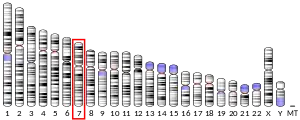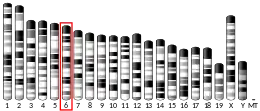LSM5
U6 snRNA-associated Sm-like protein LSm5 is a protein that in humans is encoded by the LSM5 gene.[5][6][7]
Sm-like proteins were identified in a variety of organisms based on sequence homology with the Sm protein family (see SNRPD2; MIM 601061). Sm-like proteins contain the Sm sequence motif, which consists of 2 regions separated by a linker of variable length that folds as a loop. The Sm-like proteins are thought to form a stable heteromer present in tri-snRNP particles, which are important for pre-mRNA splicing.[supplied by OMIM][7]
References
- GRCh38: Ensembl release 89: ENSG00000106355 - Ensembl, May 2017
- GRCm38: Ensembl release 89: ENSMUSG00000091625 - Ensembl, May 2017
- "Human PubMed Reference:". National Center for Biotechnology Information, U.S. National Library of Medicine.
- "Mouse PubMed Reference:". National Center for Biotechnology Information, U.S. National Library of Medicine.
- Salgado-Garrido J, Bragado-Nilsson E, Kandels-Lewis S, Seraphin B (Aug 1999). "Sm and Sm-like proteins assemble in two related complexes of deep evolutionary origin". EMBO J. 18 (12): 3451–62. doi:10.1093/emboj/18.12.3451. PMC 1171424. PMID 10369684.
- Ingelfinger D, Arndt-Jovin DJ, Luhrmann R, Achsel T (Jan 2003). "The human LSm1-7 proteins colocalize with the mRNA-degrading enzymes Dcp1/2 and Xrnl in distinct cytoplasmic foci". RNA. 8 (12): 1489–501. doi:10.1017/S1355838202021726 (inactive 2021-01-14). PMC 1370355. PMID 12515382.CS1 maint: DOI inactive as of January 2021 (link)
- "Entrez Gene: LSM5 LSM5 homolog, U6 small nuclear RNA associated (S. cerevisiae)".
Further reading
- Rual JF, Venkatesan K, Hao T, et al. (2005). "Towards a proteome-scale map of the human protein-protein interaction network". Nature. 437 (7062): 1173–8. Bibcode:2005Natur.437.1173R. doi:10.1038/nature04209. PMID 16189514. S2CID 4427026.
- Gerhard DS, Wagner L, Feingold EA, et al. (2004). "The Status, Quality, and Expansion of the NIH Full-Length cDNA Project: The Mammalian Gene Collection (MGC)". Genome Res. 14 (10B): 2121–7. doi:10.1101/gr.2596504. PMC 528928. PMID 15489334.
- Lehner B, Sanderson CM (2004). "A Protein Interaction Framework for Human mRNA Degradation". Genome Res. 14 (7): 1315–23. doi:10.1101/gr.2122004. PMC 442147. PMID 15231747.
- Ota T, Suzuki Y, Nishikawa T, et al. (2004). "Complete sequencing and characterization of 21,243 full-length human cDNAs". Nat. Genet. 36 (1): 40–5. doi:10.1038/ng1285. PMID 14702039.
- Scherer SW, Cheung J, MacDonald JR, et al. (2003). "Human Chromosome 7: DNA Sequence and Biology". Science. 300 (5620): 767–72. Bibcode:2003Sci...300..767S. doi:10.1126/science.1083423. PMC 2882961. PMID 12690205.
- Strausberg RL, Feingold EA, Grouse LH, et al. (2003). "Generation and initial analysis of more than 15,000 full-length human and mouse cDNA sequences". Proc. Natl. Acad. Sci. U.S.A. 99 (26): 16899–903. doi:10.1073/pnas.242603899. PMC 139241. PMID 12477932.
- Eystathioy T, Peebles CL, Hamel JC, et al. (2002). "Autoantibody to hLSm4 and the heptameric LSm complex in anti-Sm sera". Arthritis Rheum. 46 (3): 726–34. doi:10.1002/art.10220. PMID 11920408.
- Suzuki H, Fukunishi Y, Kagawa I, et al. (2001). "Protein–Protein Interaction Panel Using Mouse Full-Length cDNAs". Genome Res. 11 (10): 1758–65. doi:10.1101/gr.180101. PMC 311163. PMID 11591653.
- Friesen WJ, Dreyfuss G (2000). "Specific sequences of the Sm and Sm-like (Lsm) proteins mediate their interaction with the spinal muscular atrophy disease gene product (SMN)". J. Biol. Chem. 275 (34): 26370–5. doi:10.1074/jbc.M003299200. PMID 10851237.
- Achsel T, Brahms H, Kastner B, et al. (1999). "A doughnut-shaped heteromer of human Sm-like proteins binds to the 3'-end of U6 snRNA, thereby facilitating U4/U6 duplex formation in vitro". EMBO J. 18 (20): 5789–802. doi:10.1093/emboj/18.20.5789. PMC 1171645. PMID 10523320.
This article is issued from Wikipedia. The text is licensed under Creative Commons - Attribution - Sharealike. Additional terms may apply for the media files.







